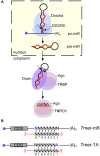Kaposi's Sarcoma-Associated Herpesvirus microRNAs
- PMID: 22563327
- PMCID: PMC3342587
- DOI: 10.3389/fmicb.2012.00165
Kaposi's Sarcoma-Associated Herpesvirus microRNAs
Abstract
Kaposi's sarcoma-associated herpesvirus (KSHV) is a human pathogenic γ-herpesvirus strongly associated with the development of Kaposi's Sarcoma and B cell proliferative disorders, including primary effusion lymphoma (PEL). The identification and functional investigation of non-coding RNAs expressed by KSHV is a topic with rapidly emerging importance. KSHV miRNAs derived from 12 stem-loops located in the major latency locus have been the focus of particular attention. Recent studies describing the transcriptome-wide identification of mRNA targets of the KSHV miRNAs suggest that these miRNAs have evolved a highly complex network of interactions with the cellular and viral transcriptomes. Relatively few KSHV miRNA targets, however, have been characterized at a functional level. Here, our current understanding of KSHV miRNA expression, targets, and function will be reviewed.
Keywords: KSHV; herpesvirus; microRNA.
Figures



References
-
- Abend J. R., Uldrick T., Ziegelbauer J. M. (2010). Regulation of tumor necrosis factor-like weak inducer of apoptosis receptor protein (TWEAKR) expression by Kaposi’s sarcoma-associated herpesvirus microRNA prevents TWEAK-induced apoptosis and inflammatory cytokine expression. J. Virol. 84, 12139–1215110.1128/JVI.00884-10 - DOI - PMC - PubMed
Grants and funding
LinkOut - more resources
Full Text Sources

